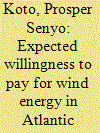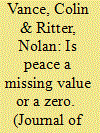| Srl | Item |
| 1 |
ID:
166448


|
|
|
|
|
| Summary/Abstract |
We investigate the demand-side of wind energy in three provinces in Atlantic Canada, including New Brunswick, Nova Scotia and Prince Edward Island. Empirical questions addressed include: (i) What are the determinants of the probability of paying a non-zero premium for electricity generated using wind technology?; (ii) Given participation, what drives how much more households are willing to pay a month, and what is the monthly premium or expected willingness-to-pay (WTP)?; and (iii) Is there heterogeneity in the expected WTP? The study design follows the contingent valuation framework and the survey questionnaire follows a payment-scale format, reducing the starting point bias and reduces the incidence of item non-response. The data is from a stratified random sample. We employ two-stage models, Cragg's hurdle and the two-part econometric models in the analysis. Scope and 0 WTP effects are explicitly explored. We find that the overall probability of participation is 0.73. University education, income, residential property ownership, concerns about the presence of wind turbines in neighborhoods, and externality affect the likelihood of participation. Households are willing to pay 14% more per month in energy bill for wind power. There is evidence of scope sensitivity. The results provide insights on what proportion of the population will participate and how much more they are willing to pay for wind energy.
|
|
|
|
|
|
|
|
|
|
|
|
|
|
|
|
| 2 |
ID:
133710


|
|
|
|
|
| Summary/Abstract |
Sample selection models, variants of which are the Heckman and Heckit models, are increasingly used by political scientists to accommodate data in which censoring of the dependent variable raises concerns of sample selectivity bias. Beyond demonstrating several pitfalls in the calculation of marginal effects and associated levels of statistical significance derived from these models, we argue that many of the empirical questions addressed by political scientists would - for both substantive and statistical reasons - be more appropriately addressed using an alternative but closely related procedure referred to as the two-part model (2 PM). Aside from being simple to estimate, one key advantage of the 2 PM is its less onerous identification requirements. Specifically, the model does not require the specification of so-called exclusion restrictions, variables that are included in the selection equation of the Heckit model but omitted from the outcome equation. Moreover, we argue that the interpretation of the marginal effects from the 2 PM, which are in terms of actual outcomes, are more appropriate for the questions typically addressed by political scientists than the potential outcomes ascribed to the Heckit results. Drawing on data from the Correlates of War database, we present an empirical analysis of conflict intensity illustrating that the choice between the sample selection model and 2 PM can bear fundamentally on the conclusions drawn.
|
|
|
|
|
|
|
|
|
|
|
|
|
|
|
|